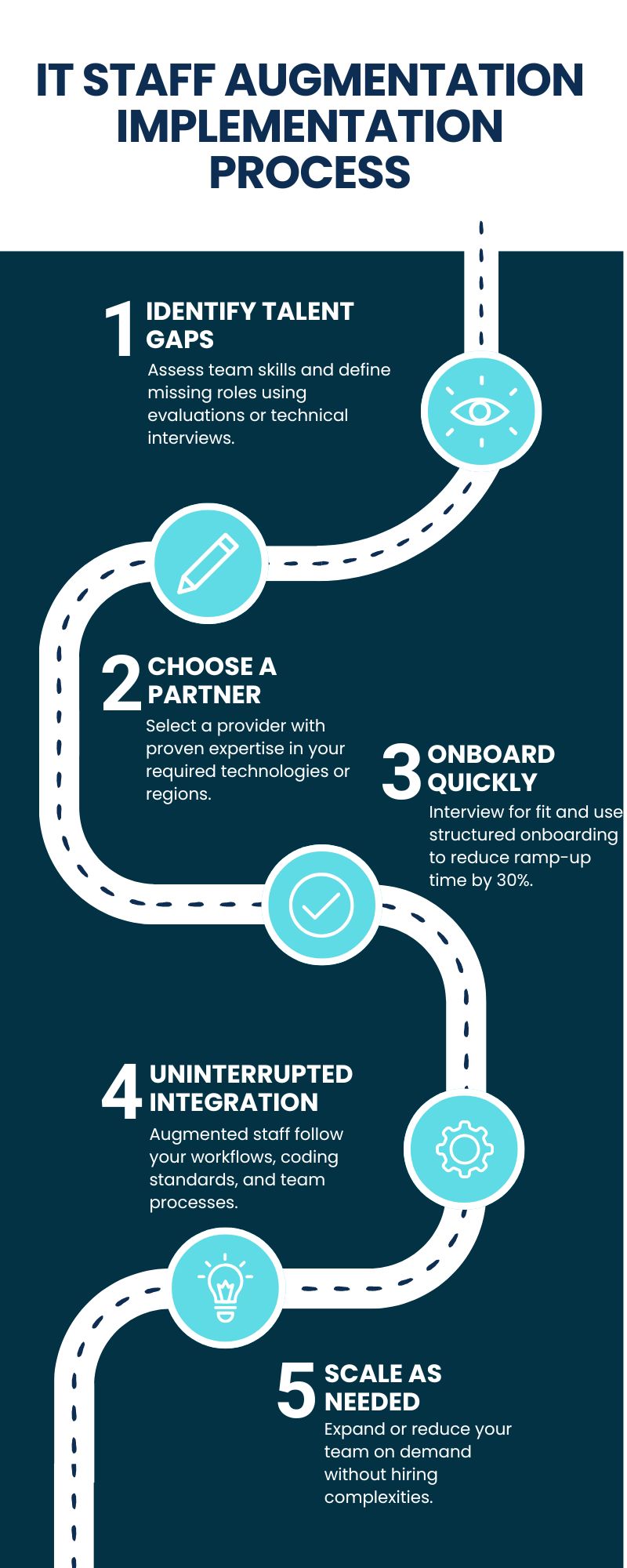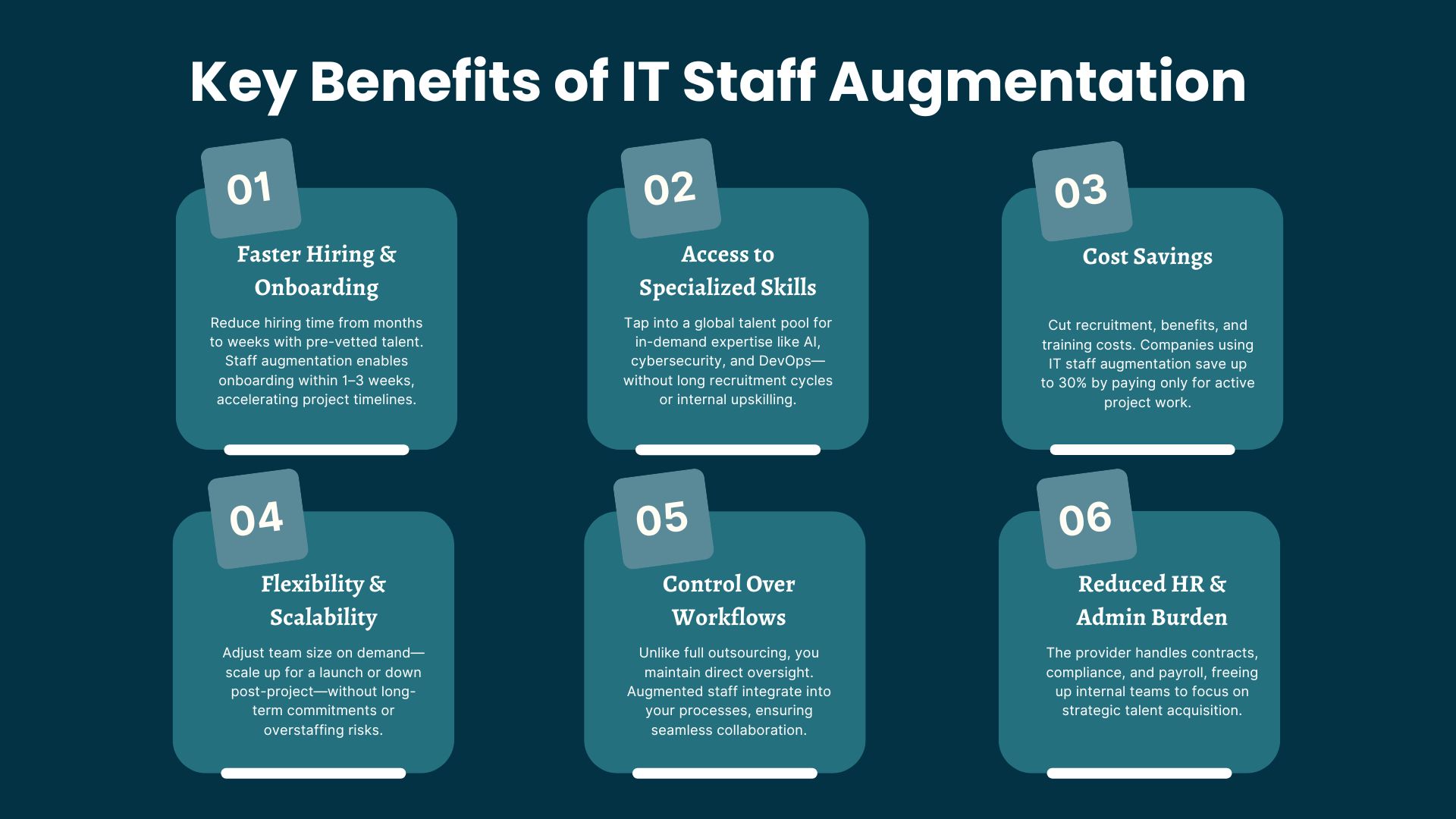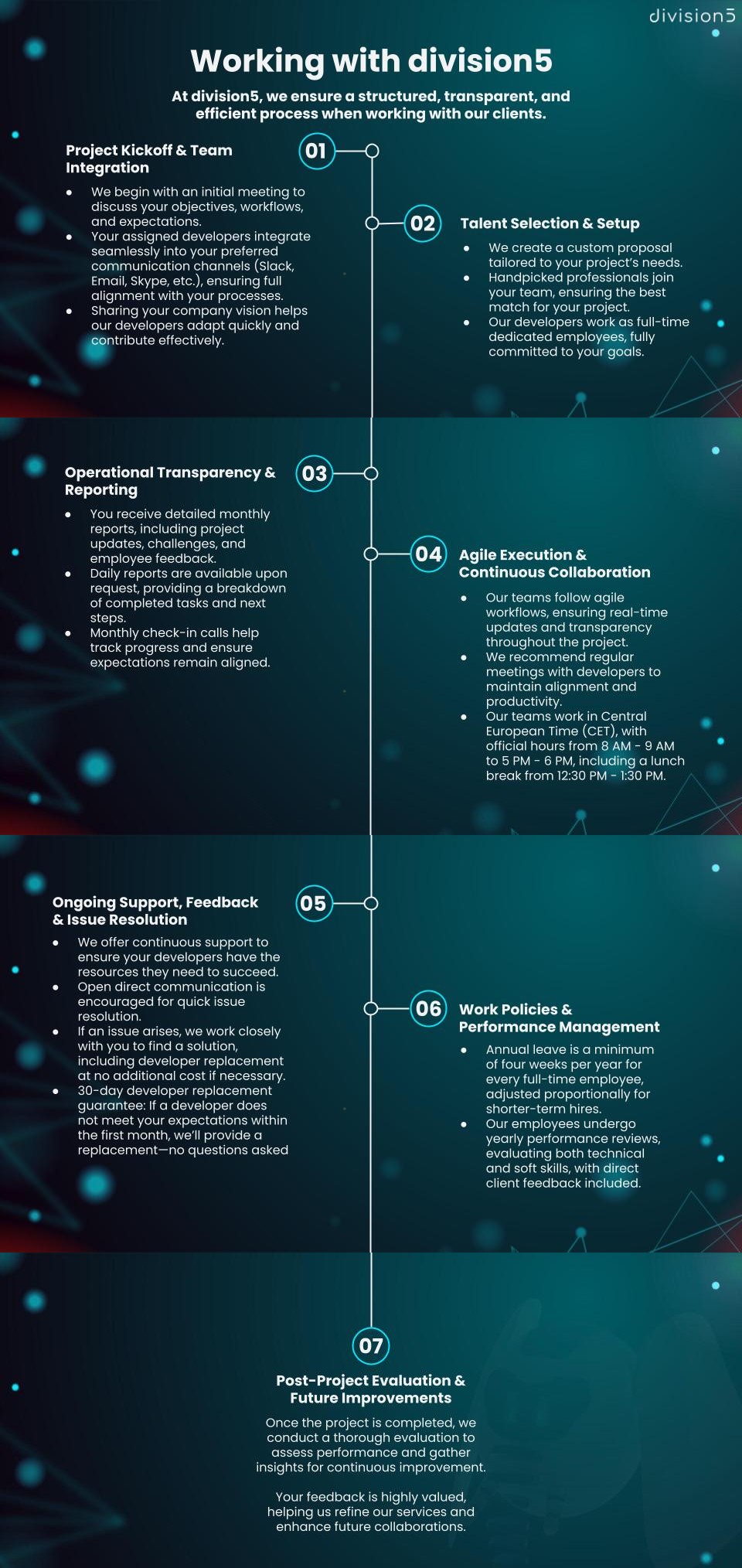
The Ultimate Guide to IT Staff Augmentation: How It Works & Why It Matters
The tech industry moves fast. Companies constantly face shifting priorities, talent shortages, and the need to scale development efforts quickly. This is where IT staff augmentation comes in:
A flexible outsourcing model that allows companies to integrate external IT professionals into their teams on a temporary or project-based basis.
Unlike traditional hiring, augmented staff remain employed by a provider, which handles recruitment, HR, and legal obligations. This allows businesses to scale their engineering capacity quickly without the long lead times and overhead costs of full-time hiring. Given the global talent shortage, this model has become increasingly popular for startups and enterprises alike.
In this guide, we’ll explore how IT staff augmentation works, its benefits, key differences from other models, and best practices for integrating augmented teams effectively. We’ll also dive into nearshore vs. offshore augmentation, common challenges, real-world case studies, and what the future holds for this hiring strategy.
How IT Staff Augmentation Works
The Process
Implementing IT staff augmentation typically follows a structured process:
- Identify Talent Gaps – Assess current team capabilities and define missing skills. This includes evaluating both immediate and long-term project needs. Some companies use internal assessments, skills matrix analyses, or technical interviews to determine which roles require augmentation. Whether it’s a front-end developer for a web project, a cloud architect for infrastructure modernization, or a cybersecurity specialist, defining clear skill requirements is crucial.
- Choose a Staff Augmentation Partner – Engage a provider with pre-vetted IT professionals. The right provider should have a strong track record of sourcing high-quality developers, designers, or engineers. Many companies compare multiple vendors, looking at past client success stories, screening processes, and available talent pools. Some providers specialize in specific technologies (e.g., Python, React, AI/ML) or regions (e.g., Eastern Europe, Latin America), making it essential to align with the right partner.
- Select & Onboard Talent – Once a provider shortlists candidates, companies must conduct interviews to ensure both technical and cultural fit. This step often mirrors a full-time hiring process but is streamlined for efficiency. Effective onboarding includes providing access to tools, documentation, and aligning new staff with the company’s development workflow. Research suggests that organizations using structured onboarding for augmented teams can reduce ramp-up time by up to 30%, allowing new hires to contribute faster.
- Integrate & Manage – Augmented staff work under your team’s direction, following your workflows. Unlike traditional outsourcing, where the vendor manages everything, augmented staff function as an extension of your internal team. Successful integration means including them in daily stand-ups, sprint planning, and Slack discussions, ensuring they follow company coding standards and participate in code reviews and retrospectives like full-time employees. Many companies also implement mentorship programs, pairing augmented staff with in-house developers to strengthen team cohesion.
- Scale Up or Down as Needed – One of the greatest advantages of staff augmentation is flexibility. If a company suddenly requires more developers for a critical deadline, the augmentation provider can add more engineers within days or weeks. Conversely, if a project concludes, the company can downsize the team without the legal complexities of layoffs. According to a Forrester study, companies using staff augmentation can accelerate product launches by 20% on average compared to those relying solely on full-time hires.

Staff Augmentation vs. Other Models
- Staff Augmentation vs. Project Outsourcing: Augmented staff integrate into your existing team and work under your supervision, whereas outsourcing means handing an entire project to an external company. With outsourcing, you rely on a vendor to deliver the final product, and the internal team has little control over daily tasks, processes, or decisions. This model works best when a company lacks in-house expertise or wants to fully delegate non-core tasks, but it can create challenges in adapting to changes mid-project or maintaining product consistency. Staff augmentation, on the other hand, ensures a direct extension of your in-house team, allowing for seamless collaboration and control over workflows.
- Staff Augmentation vs. Full-Time Hiring: Traditional hiring involves long recruitment cycles, onboarding processes, and employment-related costs such as benefits, taxes, and compliance requirements. Hiring a full-time employee can take months, whereas staff augmentation allows companies to onboard highly skilled professionals within one to three weeks. This model is ideal for short-term or fluctuating needs, as businesses can scale teams up or down as needed without long-term commitments. Additionally, many tech roles (e.g., AI specialists, cloud architects) require niche expertise that might not justify a full-time hire. Augmentation provides access to these skills on demand, reducing overhead costs while maintaining project momentum.
- Staff Augmentation vs. Managed Services: Managed service providers (MSPs) take full ownership of IT operations, offering end-to-end service management, infrastructure maintenance, and proactive monitoring. Unlike staff augmentation, where you retain control over how work is executed, an MSP functions as a separate entity that manages IT tasks independently. This model is best for companies looking to offload responsibility entirely, such as outsourcing cybersecurity monitoring or IT support services. However, for development-focused businesses that require agility, flexibility, and deeper integration with internal teams, staff augmentation offers greater adaptability without sacrificing direct management authority. Many companies use a hybrid approach, combining staff augmentation for specialized development tasks with MSPs for ongoing IT maintenance to optimize efficiency and costs.
Why IT Staff Augmentation Matters

Key Benefits:
- Faster Hiring & Onboarding – Providers supply pre-vetted talent, reducing hiring time from months to weeks. Traditional hiring can take up to 50+ days in some regions, whereas staff augmentation allows businesses to onboard skilled professionals within 1–3 weeks, significantly accelerating project timelines.
- Access to Specialized Skills – Find niche expertise that may be scarce locally. High-demand skills such as AI, cybersecurity, DevOps, and blockchain development are often difficult to recruit in-house. Staff augmentation enables companies to tap into a global talent pool, ensuring they get the right expertise without waiting months for hiring or upskilling existing employees.
- Cost Savings – Avoid recruitment, benefits, and training expenses. According to a Harvard Business Review study, businesses leveraging IT staff augmentation reduce project costs by up to 30%, as they only pay for active project involvement without incurring long-term employment expenses such as health benefits, severance, or office space.
- Flexibility & Scalability – Adjust team size as needed without long-term commitments. Whether scaling up for a product launch or reducing team size after project completion, companies have the agility to adjust workforce size dynamically. This is especially beneficial for startups and enterprises undergoing digital transformation without the risk of overstaffing.
- Control Over Workflows – Unlike full outsourcing, you retain project oversight. Augmented staff follow your company’s internal processes, coding standards, and best practices, ensuring better alignment and integration than traditional outsourcing.
- Reduced HR & Administrative Burden – The provider handles contracts, compliance, and payroll. This simplifies workforce management and allows internal HR teams to focus on strategic talent acquisition rather than administrative work. Moreover, the provider manages legal compliance regarding local labor laws, reducing risk for the client company.
Market Trends Driving Staff Augmentation
- Global Talent Shortages: 75% of European employers and 70% of U.S. companies struggle to fill IT roles.
- Post-Pandemic Remote Work Normalization: Companies are now more comfortable integrating distributed teams.
- Growing IT Outsourcing Market: The IT services outsourcing market is projected to reach $800B by 2029.
- Increased Demand for AI, Cybersecurity, and Cloud Specialists: Many companies augment these high-demand roles instead of hiring in-house.
Nearshore vs. Offshore Staff Augmentation
Nearshore Augmentation
Nearshoring involves hiring talent from geographically close regions, ensuring time-zone alignment and cultural compatibility.
- Example: A German company working with Albanian developers or a U.S. firm hiring from Latin America.
- Best For: Agile collaboration, projects requiring real-time communication.
Offshore Augmentation
Offshoring involves hiring from distant regions, often for cost savings.
- Example: U.S. companies hiring in India or Pakistan.
- Best For: Cost-sensitive projects with well-defined tasks.
Hybrid Augmentation: A Middle-Ground Approach
Some companies use a hybrid model, combining nearshore and offshore talent for optimal efficiency. This enables real-time collaboration for core tasks (nearshore) while offshoring repetitive or less time-sensitive work to reduce costs.
Choosing the Right Model
- Choose Nearshore If: You need real-time collaboration, cultural alignment, and faster communication cycles. Nearshore teams work within a similar time zone, reducing delays in feedback loops and ensuring smooth integration with in-house teams. This is ideal for agile projects, where daily stand-ups, sprint reviews, and quick iterations are crucial. Additionally, nearshoring provides greater legal and regulatory alignment, especially within regions like the EU, where data protection laws (e.g., GDPR) are a priority.
- Choose Offshore If: Cost is the primary consideration and the work can be executed independently with minimal real-time collaboration. Offshore teams typically offer significant cost savings, especially when hiring from countries with lower labor costs. However, offshore augmentation requires clear documentation, structured workflows, and strong project management to mitigate time zone differences and communication barriers. This model is ideal for well-defined tasks such as QA testing, backend development, and maintenance work that do not require constant input.
- Choose Hybrid If: You need both high-quality collaboration and cost savings. A hybrid approach allows businesses to maintain a core nearshore team for critical tasks requiring close interaction while leveraging offshore teams for cost-effective execution of well-defined components. This model is widely used in large-scale software development, where nearshore developers handle client-facing and high-priority tasks, while offshore teams focus on auxiliary functions such as bug fixes, system integrations, and infrastructure maintenance.
How the Onboarding Process Works at Division5
At division5, we believe that a structured, transparent, and efficient onboarding process is key to a successful collaboration. Our IT staff augmentation model is designed to integrate highly skilled professionals into your existing team while ensuring seamless communication, alignment, and productivity from day one:

Conclusion & Future Trends
The Future of IT Staff Augmentation
- Blended Workforces: The traditional model of employment is shifting. Companies are increasingly maintaining a mix of full-time employees, augmented staff, and freelance professionals, allowing for a highly flexible workforce. This trend will continue as businesses look for ways to stay agile in the face of economic uncertainty and rapid technological shifts.
- Nearshore Growth: As businesses seek better time-zone alignment and cultural compatibility, nearshoring will continue to grow. Companies in North America are increasingly partnering with Latin American developers, while European firms are leaning towards Eastern Europe and North Africa. Nearshoring provides a balance between cost-efficiency, collaboration, and ease of management, making it an attractive alternative to traditional offshore outsourcing.
- AI & Automation: Artificial intelligence and automation tools are becoming deeply integrated into staff augmentation models. AI-powered recruitment platforms are improving talent matching, while automation is enhancing productivity by streamlining communication, tracking performance, and optimizing workflows. This will lead to faster and more data-driven decision-making in hiring and project management.
- Evolving Collaboration Tools: The rise of virtual workspaces, AI-powered productivity tools, and enhanced cybersecurity measures is making remote and distributed teams more effective than ever. Companies are leveraging cloud-based development environments, virtual whiteboards, and real-time collaboration platforms to integrate augmented staff seamlessly. As a result, location will become increasingly irrelevant, and companies will focus more on hiring the best talent, regardless of geography.
Frequently Asked Questions (FAQs)
Final Takeaways
IT staff augmentation is a game-changing strategy that enables businesses to stay competitive, scale efficiently, and access specialized talent without the long-term risks associated with full-time hiring. As remote work becomes the norm and digital transformation accelerates, companies that embrace flexible staffing solutions will gain a significant competitive advantage.
The future belongs to those who can adapt. Is your business ready to leverage IT staff augmentation?